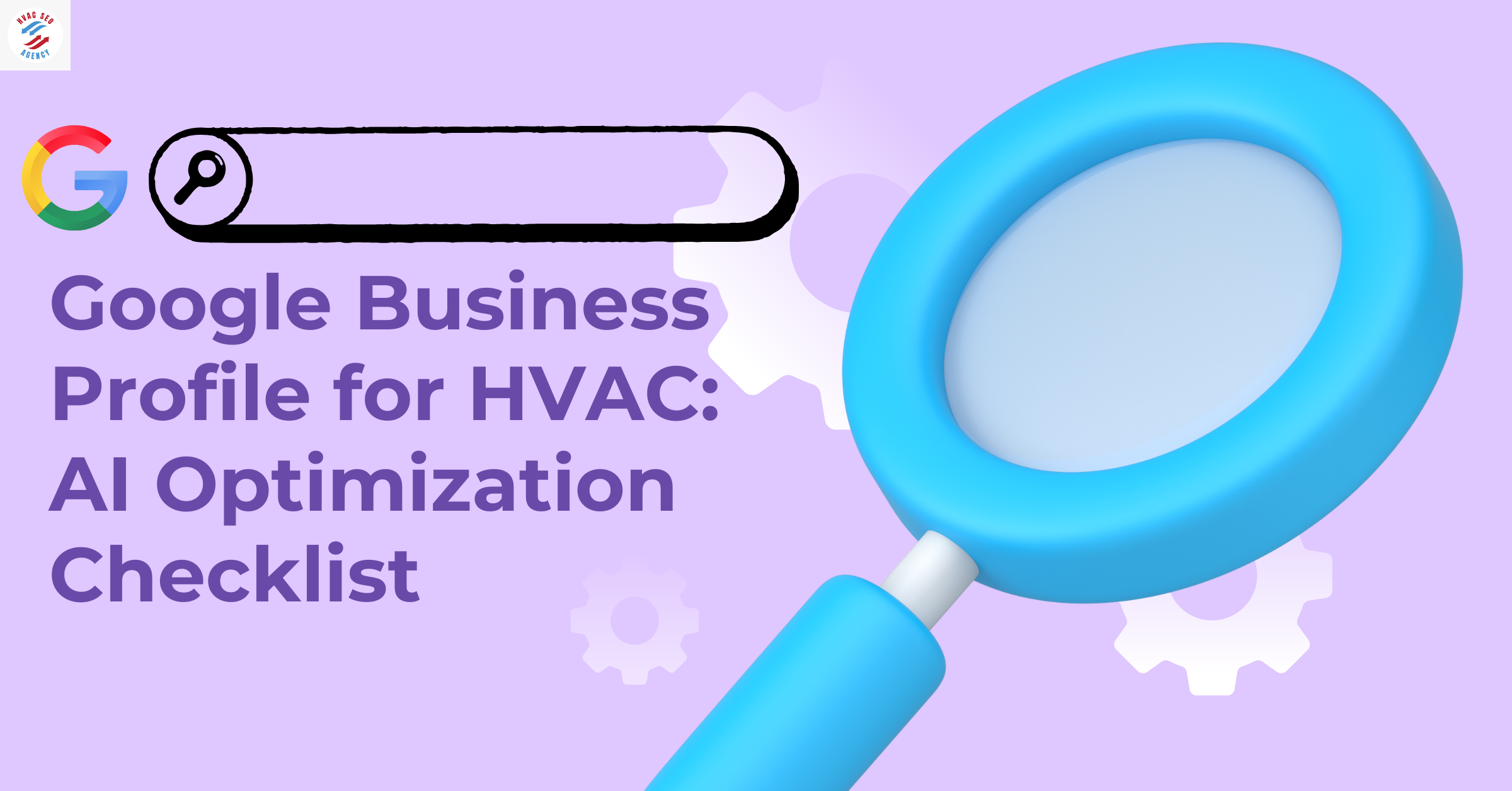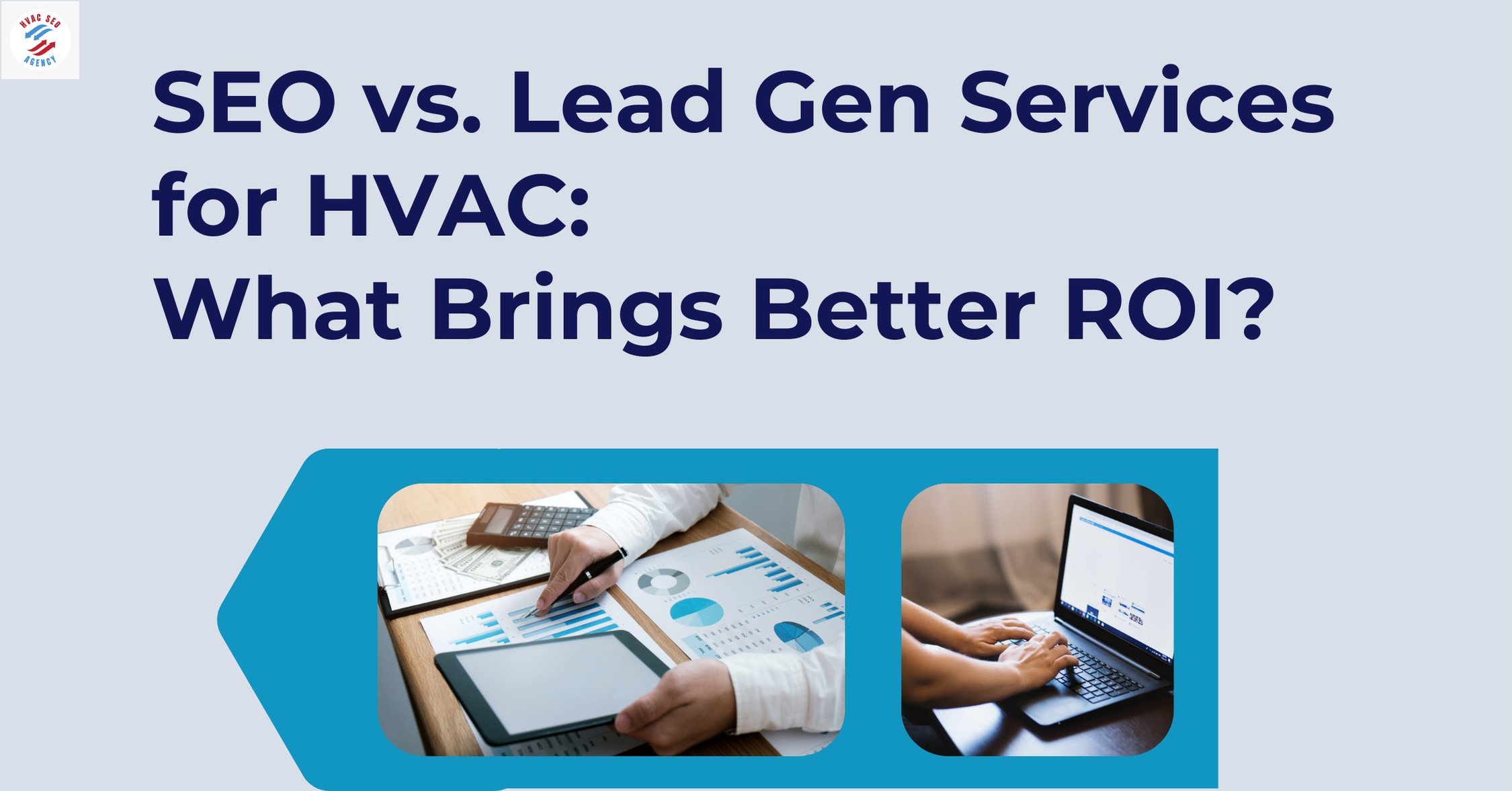The Top 10 Blog Ideas to Attract More HVAC Customers

1. HVAC Blog Topics That Win: Targeting Local Searchers for High Conversions
When planning effective HVAC blog topics, few strategies match the ROI of targeting local trends. U.S. homeowners aren’t just searching for “AC repair” they’re Googling “best HVAC contractor in Jacksonville” or “24/7 furnace repair near me.” Writing location-specific blogs that cover seasonal tips, weather-based HVAC care, or local event HVAC setups helps your site rank higher on Google and directly speak to people who are ready to buy.
According to a recent Bright Local study (2024), 87% of U.S. consumers used Google to evaluate local businesses in the past year, and 60% of local searches resulted in a direct contact or visit. This means that targeting Local SEO for HVAC Contractors through well-crafted blog content is not just a traffic game, it's a lead generation engine.
To truly dominate your market, businesses must pair these blogs with professional help from an Affordable HVAC SEO Agency in Jacksonville, which understands local keyword density, Google Business Profile optimization, and how to build local citations that drive visibility.
Table: U.S. Local Search Behavior (HVAC-Relevant Data, 2024)
Graph: Rise in "Near Me" HVAC Searches (U.S. - 2020 to 2024)
X-axis: Year (2020 to 2024)
Y-axis: Search Volume Index
Label peak growth in 2023–2024
How HVAC SEO Agencies Use These Blog Topics for ROI
An Affordable HVAC SEO Agency in Jacksonville doesn’t just rank blogs, it aligns your content with buyer intent. By crafting location-specific blog posts like:
“How Jacksonville’s Humid Climate Affects Your HVAC Efficiency”
“Winter Furnace Maintenance in Duval County A Checklist”
“Why Florida Homes Need Year-Round AC Tune-Ups”
...the agency ensures your blogs rank on Google’s first page while converting local readers into paying customers.
Local SEO isn’t optional anymore, it's essential. When your HVAC blog topics reflect local pain points and offer real solutions, you naturally build authority and trust. And trust, in local service markets, is what converts clicks into calls.
2. Educational HVAC Content That Builds Trust and Google Rankings
Why Teaching Your Customers Pays Off
The most powerful HVAC blog topics aren’t always salesy—they’re educational. U.S. consumers now expect service providers to not just offer a product but to educate them first. Writing detailed blogs on topics like “How to Choose the Right HVAC Filter” or “What SEER Ratings Actually Mean” not only improves SEO but positions your HVAC business as a credible authority.
According to Demand Gen Report (2024), 62% of U.S. consumers say they trust service brands more when they provide educational content before making a purchase decision. And blogs that include instructional content generate 3x more traffic and 2x more backlinks, which directly affects your HVAC site's Google ranking.
That’s where HVAC blog topics focused on customer education become strategic lead magnets. By giving value first, you earn organic traffic, increase time-on-site, and build loyalty all of which Google now prioritizes in its March 2025 core algorithm.
Table: Educational Blog Impact on HVAC Website Performance
Source: Semrush Content Performance Index, 2024 (U.S. Home Services Sector)
Graph: Educational Content vs. Website Engagement (U.S. HVAC Sites)
Time on Page
Backlink Growth
Conversion Rate
Use 3 bars for each category mentioned in the table above.
X-axis: Blog Type
Y-axis: Performance Metric Value
Color-coded bars for each metric
Blog Ideas That Teach and Convert
Here are five HVAC content ideas that can be turned into high-converting blog posts:
“How Often Should You Really Replace HVAC Filters in U.S. Homes?”
“The Difference Between a Heat Pump and Central AC—Explained Simply”
“Top 5 Noises Your Furnace Makes and What They Mean”
“DIY Troubleshooting Before Calling an HVAC Tech”
“What SEER2 Standards Mean for Your Energy Bill in 2025”
Each of these blog posts educates and empowers your readers while also embedding the keywords HVAC blog topics and HVAC content ideas naturally. They help your business rank while building genuine trust, especially when amplified by an HVAC SEO strategy that includes schema markup, internal linking, and helpful visuals.
SEO Agency Insight
An expert HVAC SEO agency will create internal links from these educational blog posts to your service pages. For example, a blog titled “How to Maintain Your AC Unit Year-Round” would internally link to your AC Maintenance Services page and local service area hubs. This tactic boosts both rankings and conversions.
3. Leveraging Customer Testimonials as Blog Content for Maximum Conversion
The Power of Customer Testimonials in HVAC Marketing
If you're ignoring customer stories in your HVAC blog topics, you're leaving money on the table. In the U.S., trust is a currency and nothing builds it faster than real stories from local homeowners who had a positive experience with your HVAC services.
A study by Podium (2024) found that 93% of U.S. consumers say online reviews and testimonials influence their purchasing decisions, especially for home service providers like HVAC companies. By integrating testimonials directly into your blog posts or turning them into blog posts you give skeptical visitors the social proof they need to call or book.
Here’s how the Power of Customer Testimonials in HVAC Marketing plays out:
It increases dwell time (users read more)
It lowers bounce rates
It improves conversions on service pages when blog readers click through
Instead of placing reviews on a generic testimonials page, create blog posts that narrate HVAC success stories like:
“How We Saved a Tampa Family $400 on Their Summer Cooling Bill”
“From Breakdown to Backup: A Jacksonville Heat Pump Emergency Story”
These HVAC content ideas not only humanize your brand but also offer SEO value when optimized for keywords, schema, and location.
Table: Impact of Testimonials on HVAC Marketing Metrics (U.S. Home Service Industry, 2024)
Source: BrightLocal + Podium HVAC Lead Gen Study, 2024
How to Turn Testimonials into High-Impact Blog Posts
Five HVAC blog topics based on testimonials that convert:
“Why Sarah from Atlanta Recommends Our 24/7 AC Repair Service”
“What Made Our Jacksonville HVAC Installation a 5-Star Experience”
“Customer Case Study: From 90°F to Ice Cold in Under 3 Hours”
“How We Won Over a Florida Business Owner With Emergency Duct Cleaning”
“Before and After: A Real Furnace Upgrade Story from Orlando”
Each of these HVAC content ideas is rooted in a real customer experience and can include quotes, before/after images, and service links all optimized with location-specific keywords to boost local SEO.
SEO Agency Insight
A professional HVAC SEO agency will:
Add structured data (Review schema) to testimonial blogs
Link those blogs to the related service and city landing pages
Track which blog types lead to the most calls or form submissions
This is why blending testimonial-driven storytelling with local keyword targeting is one of the most scalable content strategies in HVAC marketing.
4. Seasonal Content Strategy: Creating Timely HVAC Blogs That Drive Calls
HVAC Blog Topics That Match the Weather = More Revenue
Seasonal blog planning isn’t just about writing “winter heating tips” or “summer AC hacks.” It’s about publishing HVAC blog topics in sync with local demand trends in your service area. For instance, HVAC companies in Chicago should start publishing furnace maintenance content in late August, while those in Florida should begin pushing AC tune-up articles as early as February.
According to Google Trends U.S. (2024):
Searches for “AC tune-up near me” spike by 230% from March to May
Searches for “furnace repair” peak between October and December
If you’re not aligning your HVAC content ideas with seasonal search intent, you’re missing out on traffic that’s actively looking for services you already offer.
By using location-targeted and seasonal blog content, you meet your customer exactly when they need you. This helps boost:
Call volume
Quote requests
Emergency service bookings
Table: Seasonal HVAC Search Trends in the U.S. (2023–2024)
Source: Google Ads Keyword Planner + HVAC Search Behavior Report (U.S.), 2024
Graph: U.S. Seasonal HVAC Search Trends (2023–2024)
X-axis: Months (Jan to Dec)
Y-axis: Relative Search Volume
Mark the peak search months for AC and furnace keywords
Highlight early spring and late fall as critical content release windows
Seasonal HVAC Content Ideas That Work
Here are 5 HVAC content ideas perfectly tailored to the U.S. calendar:
“Top 5 Things to Check Before Turning on Your AC This Spring”
“Why Your Furnace Needs Servicing in September—Not December”
“How to Prepare Your HVAC System for Hurricane Season (Florida Focus)”
“Winter Troubleshooting Guide for Old Heating Systems in the Northeast”
“Summer AC Myths That Are Costing Texas Homeowners Money”
Each topic not only targets seasonal pain points but also naturally includes localized keywords. The best-performing HVAC blog topics are those that show up before the customer realizes they need help.
HVAC SEO Agency Insight
A skilled HVAC SEO agency will create an editorial calendar based on local weather data and keyword seasonality, ensuring your blogs go live 2–3 months before demand peaks. They’ll also interlink seasonal content with evergreen pages (e.g., installation, repairs), giving you ranking longevity and lead flow year-round.
This is where SEO strategy meets practical timing and that’s how your blog becomes your top sales rep.
5. Blog Content That Doubles as Internal HVAC Sales Training
Why Your Blog Should Train Techs as Well as It Attracts Leads
Many HVAC businesses overlook one of the most valuable uses of their blog: internal sales training. Well-crafted HVAC blog topics don’t just educate customers; they standardize your team’s communication. Blogs that cover service FAQs, pricing breakdowns, or warranty explanations help both your techs and your leads speak the same language.
In the U.S., 65% of HVAC field technicians interact directly with customers, yet only 23% receive formal sales training (HVACR Workforce Report, 2024). That’s a huge missed opportunity. Embedding HVAC sales training principles in your content helps your staff:
Answer customer objections faster
Recommend upgrades more confidently
Upsell maintenance contracts with clarity
When HVAC content is written with both clients and techs in mind, it becomes a dual-purpose asset enhancing both external SEO and internal team readiness.
Table: Effect of Sales-Enabled Content on Team & Revenue (U.S. HVAC Firms)
Source: ServiceTitan HVAC Benchmark Report, 2024
SEO Agency Insight
A forward-thinking HVAC SEO agency will identify blog posts that get the most traffic from buyers at the decision stage (e.g., pricing, warranties, replacements). These blogs should be optimized with CTA buttons, internal service links, and downloadable sales sheets for in-house use making your HVAC blog a real revenue driver.
6. Boosting Engagement with Visuals: Infographics and Explainer Videos in HVAC Blogs
Why Visuals Should Be at the Core of Your HVAC Blog Strategy
A long block of text might be informative but if your readers don’t engage with it, your SEO efforts fail. Visual content like infographics, GIFs, and explainer videos are no longer optional. They dramatically increase retention, reduce bounce rate, and improve conversion, especially in the U.S. HVAC market where technical concepts can overwhelm average homeowners.
According to Wyzowl’s U.S. Consumer Video Report (2024):
86% of people say video helps them understand a product or service better
HVAC websites with explainer videos see a +74% increase in time-on-page
Blogs with at least one infographic generate 4x more shares and backlinks
Using media-rich HVAC blog topics (e.g., “How a Heat Pump Works in 60 Seconds” or “Step-by-Step: Change Your HVAC Filter”) drives both traffic and clarity. It also positions your brand as modern, transparent, and easy to work with.
Table: Effect of Visual Content on HVAC Blog Performance (U.S.)
Source: Wyzowl + HubSpot Content Engagement Benchmark, 2024 (Home Services Sector)
Graph: Visual Content vs. HVAC Blog Performance Metrics
Time on Page
Backlink Growth
Conversion Rate
For each content type:
Text-only Blog
Blog + Infographic
Blog + Explainer Video
X-axis: Content Format
Y-axis: Metric Value (min / %). Label each metric clearly.
Visual-Based HVAC Blog Topics That Attract and Convert
Here are five HVAC content ideas that should include visuals:
“How a Furnace Works Explained in 3 Steps with Graphics”
“AC Maintenance Checklist (Downloadable Infographic for Spring 2025)”
“How to Tell If Your Thermostat Is Broken [Video Guide]”
“SEER Ratings Made Simple: Infographic for U.S. Homeowners”
“What Happens During an HVAC Tune-Up? Watch the Full Process”
These HVAC blog topics deliver complex information simply, keeping users on the page longer and increasing the chance of sharing, bookmarking, or booking a service.
SEO Agency Insight
A top-tier HVAC SEO agency will:
Embed schema for video or image content
Optimize infographics for fast load speeds and mobile
Use video transcriptions to rank for long-tail keywords
A/B test blog designs to identify the best visual layout for lead capture
Pairing educational content with strategic visuals turns casual blog visitors into confident customers and confident customers convert faster.
7. Data-Driven Blogging: How to Let Real HVAC Metrics Guide Your Content Strategy
Let Data Decide Your Next Blog Topic
Guessing what to write next is not a strategy for analyzing performance data. The most effective HVAC blog topics are backed by metrics from tools like Google Search Console, Google Trends, and HVAC CRM software. When you know which pages are getting traffic, which search terms are driving calls, and which blog posts convert best, you can repeat and scale that success.
According to HubSpot’s 2024 U.S. Content Marketing Report, blogs that are planned using analytics are:
2.5x more likely to generate leads
3.7x more likely to rank in the top 3 search results
2x more likely to be shared or linked to by other websites
Data also tells you what not to write by identifying HVAC content ideas with high impressions but low clicks, low dwell time, or high bounce rates. These signals allow you to either improve the content or replace it with a more targeted post.
Table: Blog Performance with vs. Without Data Strategy (U.S. HVAC Companies, 2024)
Source: HubSpot + HVAC SEO Industry Report, 2024
Graph: HVAC Blog Performance Intuition vs. Data Strategy
Without Data Strategy
With Data Strategy
Metrics to include:
Organic leads/month
Blog CTR
Bounce Rate (use inverted axis)
Top 10 keyword rankings
Use color-coded bars and label all values for clarity.
Smart HVAC Blog Topics Backed by Data
Here are five HVAC content ideas that typically perform well based on search trends and click behavior:
“Most Searched HVAC Problems in 2024 (And How to Fix Them)”
“Why ‘AC Not Cooling’ Is the Top Search Term in July—and What It Means”
“Top 5 Questions Our Customers Ask (Based on 1,000+ Service Calls)”
“Is It Time to Replace Your Unit? Data Says Yes If You See These 3 Signs”
“What Google Trends Tells Us About HVAC Needs in Texas”
These HVAC blog topics are designed not from imagination, but from data and that’s why they attract real, high-converting traffic.
SEO Agency Insight
An experienced HVAC SEO agency will:
Run monthly content performance reports
A/B test blog titles and intros based on CTR
Identify top-performing blog clusters and build supporting content around them
Use keyword cannibalization audits to consolidate or retarget underperforming posts
This data-first approach to HVAC content ensures you're not just blogging more but blogging smarter, with ROI in mind.
8. Repurpose and Multiply: How One Blog Post Can Fuel 10 Marketing Channels
HVAC Blog Topics Don’t Die They Diversify
Your best-performing HVAC blog topics shouldn’t sit idle on your website; they should be repurposed into videos, social posts, email campaigns, and service scripts. In the U.S., omnichannel marketing has become essential for HVAC brands, especially as consumer attention is now fragmented across Google, Instagram, YouTube, email, and even local newsletters.
A Content Marketing Institute (2024) report reveals:
Brands that repurpose blogs across 5+ channels see a +73% increase in marketing ROI
Repurposed HVAC content increases audience engagement by 2.8x
Email newsletters using repurposed blog content see click-through rates (CTR) jump from 4.2% to 9.7%
Repurposing doesn’t mean duplicating, it means adapting. One blog about “Winter HVAC Tips” can turn into:
A short YouTube explainer
5 LinkedIn carousel posts
3 Instagram reels
1 downloadable checklist
A sales talking point for field techs
This is how HVAC content ideas scale without more writing effort, just smarter asset reuse.
Table: Impact of Repurposing HVAC Blogs Across Channels
Source: CMI Multi-Channel HVAC Engagement Survey, 2024
Graph: ROI Increase from Repurposed HVAC Blog Content (U.S.)
Email
YouTube
LinkedIn
Instagram
Sales Decks
X-axis: Engagement boost (%)
Y-axis: Channels
Label each bar with actual % increase for visual clarity.
Repurposing-Ready HVAC Blog Topics
Here are five HVAC blog topics that repurpose especially well:
“The Complete Seasonal HVAC Maintenance Guide” → YouTube series, carousel, checklist
“How to Lower Your AC Bill This Summer” → Newsletter series + Instagram Reels
“Why Your Furnace Smells Funny—And What to Do” → Story highlight + email content
“AC Tune-Up Checklist for Homeowners” → Lead magnet PDF + field tech printout
“Should You Repair or Replace? A Cost-Based Guide” → LinkedIn poll + webinar outline
These HVAC content ideas should be built from the start with cross-platform potential in mind. The goal is not to create more content but to extract more value from the content you already have.
SEO Agency Insight
An advanced HVAC SEO agency will:
Track top-performing blog posts using Google Analytics and heatmaps
Identify which content formats perform best on different platforms
Set up UTM tracking links for repurposed content to monitor actual lead value
Design templates for carousel posts and checklists to automate the repurposing process
In the modern HVAC landscape, blogging is just step one. Scaling that blog across platforms is how you turn content into a lead-generating machine.
9. Voice Search & Mobile SEO: The Overlooked Goldmine in HVAC Blogging
Why “Hey Google” Should Influence Your HVAC Blog Topics
The way people search for HVAC services in the U.S. is rapidly evolving. Nearly 50% of all online searches are now voice-based, and over 63% of HVAC-related queries come from mobile devices (Think with Google, 2024). If your HVAC blog topics aren’t optimized for how people speak their queries or aren’t mobile-first in design, you’re missing out on urgent, high-intent traffic.
Voice search queries are longer, more conversational, and hyper-local. A text-based search might be “AC repair,” but a voice search sounds like:
“Who can fix my air conditioner near me right now?”
“Why is my heater blowing cold air in January?”
Table: HVAC Blog Performance – Mobile vs. Desktop (U.S. Home Services Market, 2024)
Source: Google Search Central Mobile UX Report, 2024
Graph: HVAC Blog Performance Mobile vs. Desktop Engagement
Bounce Rate
Time on Page
Conversion Rate
Use color-coded bars for each device type. Add value labels for each bar to enhance visual interpretation.
HVAC Content Ideas Built for Voice and Mobile Discovery
Here are five HVAC content ideas optimized for voice and mobile users:
“Why Isn’t My AC Cooling? Ask This Before You Call”
“Best HVAC Settings for Energy Saving Answered in 60 Seconds”
“Who Fixes Heaters on Weekends in [City]? Here’s What to Know”
“How Often Should You Service Your AC Unit? A Quick Guide”
“How to Troubleshoot Your Thermostat (Even If You’re Not Tech-Savvy)”
Each of these HVAC blog topics mimics how real people speak, and when designed mobile-first (larger fonts, clear CTAs, collapsible sections), they drive more clicks, more calls, and more trust.
SEO Agency Insight
An advanced HVAC SEO agency will:
Use schema markup for FAQs and How-To sections
Structure headers in conversational formats
Implement AMP or fast-loading mobile frameworks
Run voice search simulations using tools like SEMrush Voice Search Tracker
Optimizing your HVAC content for voice and mobile isn’t optional, it's essential for ranking in 2025 and beyond. Your future customer is speaking to Google. Your blog should be the one that answers.
FAQs: HVAC Blog Topics That Drive Leads and SEO
1. What are the best HVAC blog topics to attract new customers?
The best HVAC blog topics are those that solve specific problems, answer local search queries, and reflect seasonal demand. Examples include “Why Is My AC Leaking?”, “Best HVAC Settings for Winter,” or “Furnace Maintenance Checklist for Illinois Homes.” These types of blogs address real-time needs and rank well on Google.
2. How do I come up with new HVAC content ideas each month?
Start with customer service questions, Google’s “People Also Ask,” and voice search patterns. Tools like Google Trends, SEMrush, and AnswerThePublic offer topic inspiration based on actual U.S. search data. You can also analyze your HVAC competitors and top-performing blogs for gaps.
3. Should my HVAC blog focus on local SEO or general tips?
Both. Use general HVAC blog topics for broad visibility and local-focused content (e.g., “Best AC Service in Phoenix”) to convert high-intent traffic. An ideal content strategy includes both evergreen and geo-targeted HVAC content ideas.
4. How often should an HVAC company publish blog content?
Top-performing HVAC websites in the U.S. post 2–4 blogs per month. Consistency helps build topical authority, improve indexing frequency, and outperform competitors. Repurposing blogs into videos or social posts adds further reach.
5. Can a blog really generate HVAC leads and revenue?
Yes. When optimized with proper keywords, CTAs, visuals, schema, and internal links, blogs become high-performing landing pages. U.S. HVAC companies that blog strategically report 2x–3x more qualified leads within 6–12 months.
Conclusion: Turn HVAC Blog Topics Into Revenue-Generating Machines
In today’s competitive HVAC market, blog content isn't just a nice-to-have, it's a growth engine. The right HVAC blog topics do more than educate. They attract the right traffic, build trust, support sales, and convert readers into paying customers.
From seasonal maintenance guides and testimonial-driven stories to visual infographics and data-powered posts, each blog can serve multiple business goals: SEO, lead generation, sales training, local ranking, and customer retention.
Backed by a qualified HVAC SEO agency, your content strategy becomes even more powerful. With keyword research, mobile-first formatting, voice search optimization, and multi-channel repurposing, your blog becomes a full-scale marketing asset not just a web page.






